I’ve written recently about watches from the French company Lip, and this time it’s a watch from another French company, Yema.
(Click pictures to enlarge)
Yema was formed in Besançon France in 1948 by Henry Louis Belmont who employed a team of young watch technicians with the intention of putting French watchmaking on the map. Things went well, and by the late 1960’s Yema were already producing 500,000 watches per year and were the first French watch company to produce a chronometer rated calibre.
The 1970’s were good years for Yema who produced a number of popular (and now collectible) watches, most notably a range of Valjoux powered chronographs including the Flygraf, Navygraf and Yachtingraf.
They also produced a line of popular divers watches such as this Superman model which has a look of the Heuer diver with French roots which I wrote about recently (see that post here).
Production had been increasing steadily over the years and had reached 2 million per year by the early 1980’s. Henry Louis Belmont stepped aside in 1982 and passed control of the company across to his son, after which “the wheels came off” you might say.
The company was quickly sold and though the brand name remained intact, the company changed hands several times over the next 20 years. The quality of the watches quickly deteriorated, the brand image suffered, and production decreased to just over 100,000 units per year.
It looked like the end of the road for Yema when the company filed for bankruptcy at the end of 2008. However, all was not lost as a French company, Ambre, stepped in and purchased the brand, making it a wholly French owned company again.
The watch in this post is from the Sous Marine range which was first introduced in 1953, though this one is from the 1970’s. This model has a rotating inner bezel which is turned using the upper crown and inside is a 17 jewel, French Ebauche (FE) cal. 4611 automatic.
The watch arrived in running condition but badly needed a service. As you may have seen in the first picture the lume in the hands had literally turned to dust and distributed itself across the entire watch.
After servicing the movement it was on to the cosmetic issues. The hands were relumed and the dust was carefully removed from the dial, inner bezel and inside the case which finished the job.
I’m intrigued by the second scale on the dial on this watch. “Temps Ecoule” means running time and “Moyenne” means average, but I’ve got no idea how you would use it. I don’t think it is related to the scale on the inner bezel but I could be wrong. If anyone can tell me what this scale is for and how to use it, I’d be much obliged.
You can see the current Yema lineup here, which still includes a sprinkling of automatic models I’m pleased to say.
Rich.
** Many thanks to Dave Noke for letting me feature his watch on the blog. **

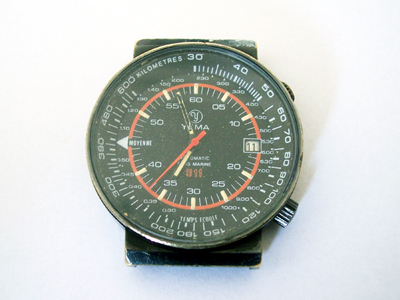
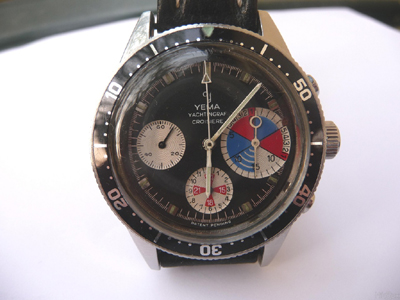
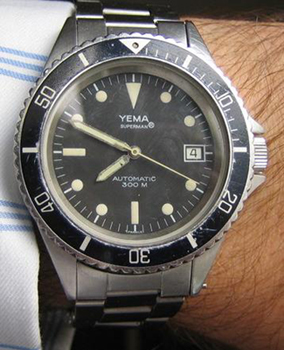
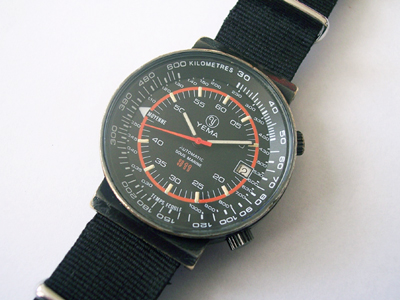
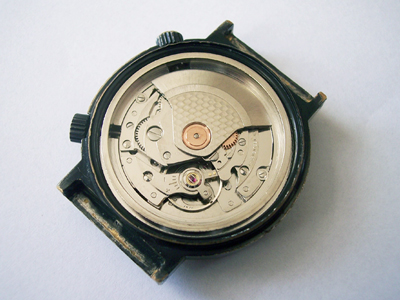
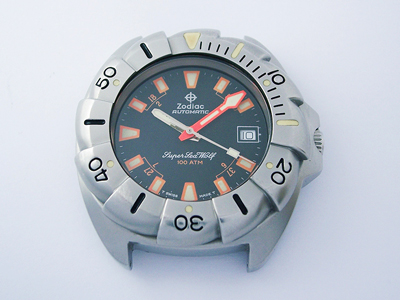
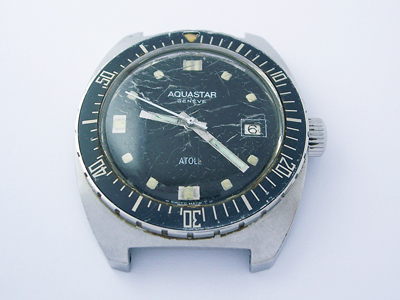
Well, I was wrong in my previous post, or at least I think I was. I think the scales of your watch, and other Yema “meangraf” models are unique. For me this is an exciting discovery!
From what I can figure, the outer scale is marked in kilometers and the inner scale is marked in minutes. The minute markings are a bit strange. One hour and twenty minutes is marked 120. 200 means 2 hours exactly. You turn the bezel to line up the distance you’ve traveled on the outer scale with the time it took you to travel that distance on the inner scale. Your average speed is the number at 9 o’clock, directly across from 1 hour on the time scale (marked “Moyenne” on your watch which I think means “average” in French). Pretty cool!
Anyway, I’d like to use a picture of your watch on my website. Let me know.
Hi,
Interesting watch! I’d call this a “rally style” slide rule watch. It has one logarithmic scale that rotates around a fixed time scale. This type of functionality first appeared on the Breitling Navitimer. You can use it to calculate average speed or estimated time of arrival. Yema has a long and interesting history of producing slide rule watches.
-Art